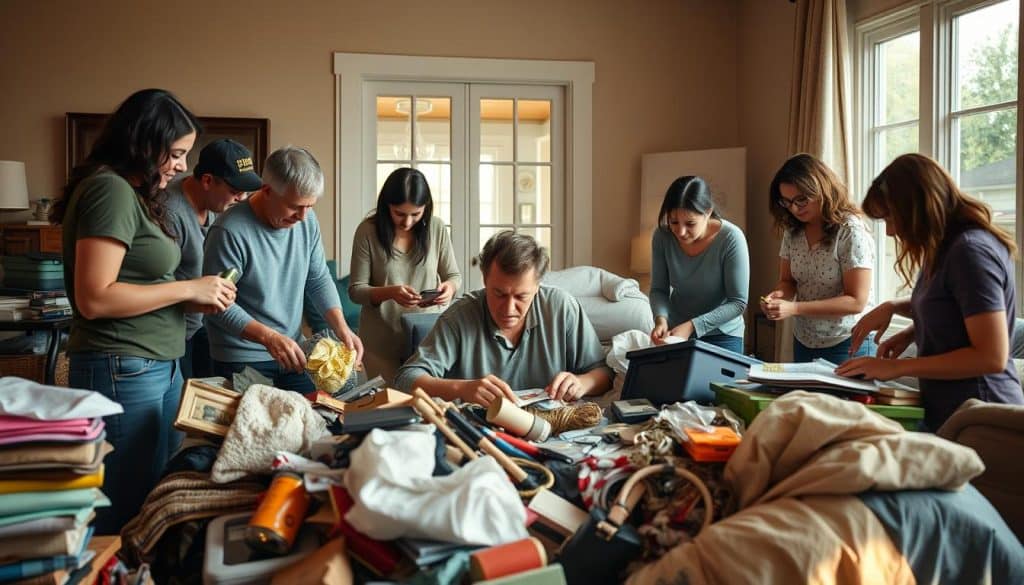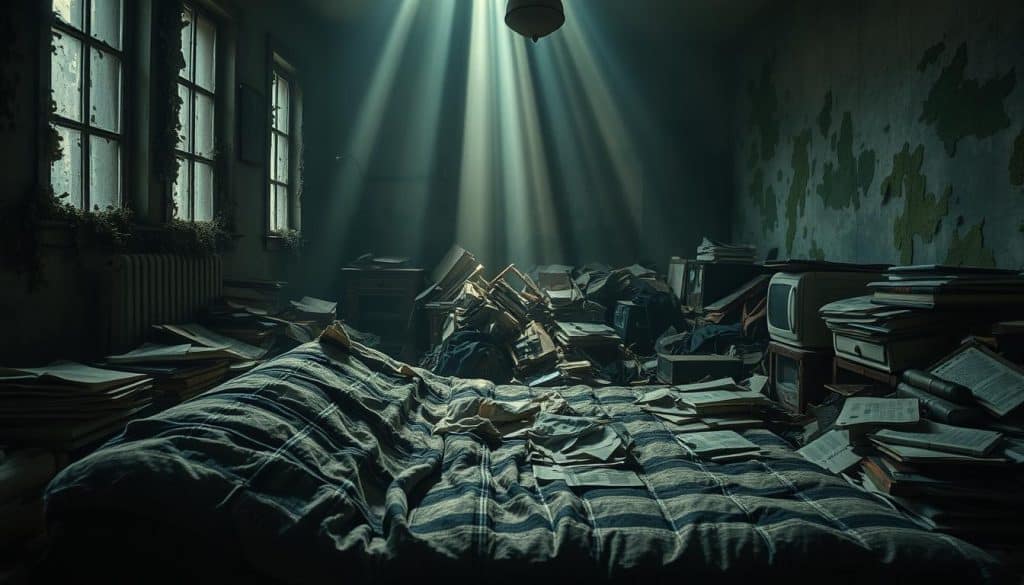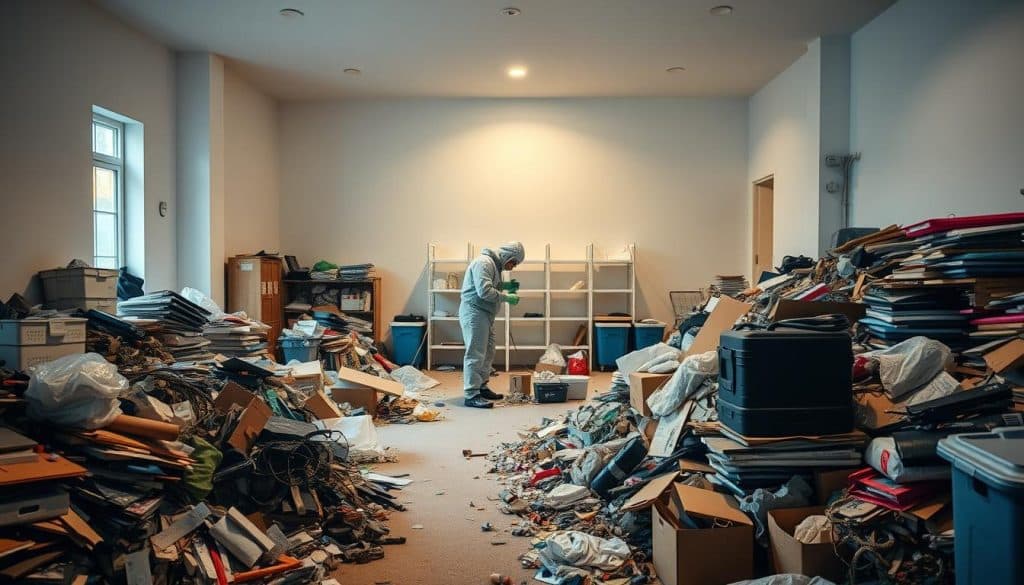Table of Contents
Ever wondered How Do You Prepare For a Hoarding Cleanup? or how to clear a space full of clutter? Preparing for a hoarding cleanup is tough and complex. It needs careful planning and understanding of physical and emotional factors.
When preparing for a hoarding cleanup, remember the health risks. These include dust, mold, and even biohazards like rotting food. Clutter not only poses dangers but can also harm your home’s structure, making safety a top concern.
Getting help from hoarding cleanup professionals is key. They offer services tailored to tackle these challenges. In this article, we’ll explore the steps to a thorough and caring cleanup.
Key Takeaways
- Understanding hoarding cleanup involves recognizing psychological and physical aspects.
- Health risks can arise from airborne hazards and biohazards during cleanup.
- Strategic planning is essential for an effective hoarding cleanup process.
- Engaging professionals ensures safe and efficient management of clutter.
- Emotional support plays a critical role in the cleanup journey.
- Proper protective gear is vital to mitigate health risks during the process.
Understanding Hoarding Cleanup
Hoarding disorder is a complex condition where people accumulate too many items. This makes it hard to use their living spaces. About 2-6% of the world’s population has this disorder. Many struggle with clutter because of mental health issues like anxiety or depression.
It’s important to understand the hoarding removal process. Each situation is unique, and tackling it requires special care.
What is hoarding?
Hoarding is more than just being disorganized. It’s about strong emotional ties to possessions. Often, these ties come from traumatic experiences. People with hoarding disorder find it hard to throw away items.
This leads to dangerous and unsanitary living environments. Clutter can be so bad that it blocks the use of spaces. This makes people feel anxious and isolated.
Why is cleanup necessary?
Cleanup is needed to remove life-threatening hazards in hoarded spaces. It makes living areas safe again. It also brings emotional relief to individuals and their families.
Professional hoarding cleanup services focus on each unique situation. They prioritize the well-being of those affected.
The impact of hoarding on health
The health risks of hoarding are serious. Cluttered environments can harbor mold and pests. These are biohazards that pose health risks.
Studies show that 75% of people with hoarding disorder face daily life challenges. Effective cleanup tips are key to safer, healthier living.
Assessing the Situation
Knowing how bad the hoarding is is the first step to a good cleanup. This step helps plan the cleanup safely. Hoarding affects 2-6% of people, meaning many need help.
Seeing how much clutter there is helps make a plan. This plan makes the cleanup go smoothly.
Identifying the extent of hoarding
It’s important to know how bad the hoarding is. Clutter can make rooms unusable. People with hoarding may have ten to twenty times more stuff than others.
More than half of hoarders don’t see their behavior as a problem. Getting them to agree to clean up can be hard.
Evaluating hazardous materials
Checking for dangerous materials is key during cleanup. About 30-50% of hoarded homes have mold. This can cause breathing problems.
Fire risks are also high, with 50% of hoarding cases being fire hazards. Fixing these dangers quickly makes the cleanup safer.
Understanding emotional attachments
Helping emotionally is key to a successful cleanup. People with hoarding issues often feel anxious about getting rid of things. Knowing this helps those helping to be gentle.
Many hoarders want to clean up but find it hard. They struggle with letting go of their stuff.
Developing a Cleanup Plan
Creating a good cleanup plan is key when dealing with hoarding. Setting goals helps focus efforts and builds momentum. This approach makes progress clear and keeps things positive.
Setting realistic goals
It’s key to set goals that are doable. These goals should fit the needs of the person with hoarding. Knowing the amount of clutter helps plan tasks for a certain time.
Creating a timeline
A clear timeline keeps the cleanup on track. Many people don’t realize how long it takes to clean up hoarding. Breaking it down into smaller steps helps avoid feeling overwhelmed.
It sets clear goals for success.
Budget considerations
Looking at the costs of cleaning is important. Families often face unexpected expenses. Budgeting carefully covers costs like professional services and waste disposal.
This helps plan resources and know when to ask for help.

Engaging Professionals
Dealing with hoarding situations often requires help from skilled professionals. Contact Array of Solutions when things get too much for friends and family. They offer not just cleanup but also emotional support, which is key in these situations.
When to contact Array of Solutions
Knowing when to ask for help from hoarding cleanup professionals is important. If clutter makes daily life hard or makes your home unsafe, it’s time to call. Array of Solutions is great at handling tough cases with care and understanding.
Benefits of using certified experts
Using certified mold inspector services is vital for dealing with dangers like mold and waste. These experts know how to remove these hazards safely, protecting your health. They also offer emotional support, making the process easier for clients.
What services do we offer?
Array of Solutions provides a wide range of services for hoarding cleanup. We do mold testing and removal, clear out clutter, offer emotional support, and help after the cleanup. Our goal is to make your space safe and help you manage your hoarding.
Gathering Resources
Getting the right tools is key for a successful hoarding cleanup. You need the right supplies to stay safe and work well. Planning ahead helps avoid dangers and makes the job easier.
Essential cleanup supplies
You’ll need things like trash bags, cleaning products, and sorting bins. These help start the decluttering and organizing. Having enough of these items makes the cleanup go smoothly.
Personal protective equipment (PPE)
PPE is very important for keeping workers safe in dangerous places. You’ll need gloves, masks, and eye protection. This gear helps protect against mold, dust, and other harmful stuff.
Tools and equipment needed
The tools you need depend on the job but often include brooms, vacuums, and dumpsters. These help clear out messes quickly. Using the right tools makes the cleanup more effective and keeps workers safe.
Involving Family and Friends
Getting family and friends to help with hoarding cleanup is key. Talking about the plan clearly sets everyone’s expectations. It makes the work easier and less stressful for the person affected.
Communicating the plan
Talking about what needs to be done helps avoid confusion. It’s good to discuss who will do what and when. This way, everyone knows their part and can feel more involved.
Assigning roles and responsibilities
It’s smart to give each person a specific job. This could be sorting, organizing, or taking out the trash. It makes the work go smoother and helps the person struggling feel less overwhelmed.
Emotional support during the process
Cleaning up can make people feel many emotions, like guilt or worry. It’s important for family to be there to support them. Regular check-ins and words of encouragement can really help.
If needed, getting professional help is a good idea. More information is available at this helpful link.

Sorting and Decision Making
Sorting items in a hoarding cleanup needs a clear plan. It’s best to sort things into four groups: keep, donate, recycle, and throw away. This method makes it easier to decide what to do with each item. It helps when you’re feeling overwhelmed by your feelings about certain items.
Creating clear categories helps you make better choices. It’s important to respect your feelings but also to think clearly about your belongings.
Categories for sorting items
Having clear categories makes sorting easier. The “Keep-Toss-Donate” method works well. Put things you really need or love in the ‘keep’ category. Things you don’t need anymore can be donated or recycled.
Items that are broken or dangerous should be thrown away. This system helps you make decisions more efficiently.
How to make decisions about belongings
Deciding what to do with your belongings can be tough. One way to help is to set clear criteria for each item. Ask yourself if you’ve used it recently or if it makes you happy.
Getting help from professionals or friends can also help. They can offer new ideas and support, making it easier to make decisions.
Tips for managing sentimental items
Dealing with sentimental items needs extra care. If it’s hard to let go, try using temporary storage. This lets you keep items close while you think about them.
Getting ongoing support and therapy can also help. It can make it easier to deal with your feelings and move forward.
Disposing of Unwanted Items
Getting rid of unwanted items is key in cleaning up hoarding situations. Knowing the local rules for disposing of these items is important. It ensures everything is done right and safely.
Cleaning up isn’t just about getting rid of clutter. It’s also about finding the right ways to get rid of unwanted items. This helps the environment and makes the space better.
Local disposal regulations
Every place has its own rules for getting rid of hazardous materials found in hoarding. It’s important to know these rules to avoid fines and keep everyone safe. Following the right steps for disposing of hazardous waste is a must.
This keeps the community and the environment safe during the cleanup. It’s a big part of making sure everything is done right.
Recycling options
Recycling is a big help in reducing waste from hoarding cleanups. Many items like paper, cardboard, and metals can be recycled. This helps the environment and shows we care about sustainability.
By recycling, we’re not just cleaning up. We’re also doing our part for the planet. It shows we’re committed to taking care of our environment.
Donation opportunities
Donating items from hoarding situations helps two ways. It helps people in need and supports local charities. This is a win-win for everyone involved.
Choosing what to donate wisely can make a big difference. It helps those in need and makes the space cleaner. It’s a way to give back and help others.
Addressing Mold Issues
When cleaning up hoarding, it’s key to tackle mold problems. Spotting mold signs like musty smells or unusual spots is the first step. Mold loves dark, moist spots, like closets near bathrooms or basements.
Identifying signs of mold
Look out for dark patches on walls, musty smells, and dampness in tight spaces. Places with humidity over 60% are perfect for mold. Regular cleaning in these areas helps keep mold at bay.
Importance of mold testing
Mold testing is vital to know how bad the problem is. It helps figure out the best way to fix it. The EPA says pros have tools to find and remove all mold, making cleanup complete.
Using French drains as a solution
French drains help stop mold by managing moisture. They keep water away from your home’s base, keeping humidity levels right. This improves air quality and lowers mold risks.

Ensuring Safety During Cleanup
When cleaning up hoarding situations, safety is a top priority. It’s important to know about health risks like mold and debris. This knowledge helps set up safe workspaces and prepare for emergencies.
Health risks to consider
Hoarding poses serious health dangers. Mold can cause breathing problems and infections. Clutter can lead to fires and block exits, raising injury risks.
By taking safety steps, we can reduce these risks. This makes the cleaning process safer and more effective.
Setting up safe workspaces
Creating safe work areas is essential. It’s important to use Personal Protective Equipment (PPE) like gloves and masks. Good ventilation also helps, cutting down airborne particles by half.
Securing the area helps prevent accidents. This reduces exposure risks by about 70%.
First aid preparedness
Being ready for first aid is critical. First aid kits should have the right supplies, and everyone should know how to respond in emergencies. Quick medical help can prevent injuries and delays.
Organizations like Trauma Clean 24 Seven stress the importance of being prepared. They help ensure safety during the cleanup.
After the Cleanup: Preventing Future Hoarding
Keeping your living space clean is key after the cleanup. A good plan helps you stay organized and avoid hoarding. It makes you feel in control and not overwhelmed by stuff. Having your family support you is also very important.
Maintaining organization
Having a good system for organizing is the first step. It means having a place for everything and getting rid of things you don’t need. It helps your mind stay clear and makes you feel better.
Setting limits on new items
It’s important to be careful about what you bring into your home. Think hard before you buy something new. This helps you manage what you already have and teaches you to be mindful of what you buy.
Regular inspections and family support
Checking in regularly can help catch any signs of hoarding. Having your family support you is key. They can help you stay on track and feel supported in your journey.
Contacting Array of Solutions for Help
Dealing with hoarding cleanup can be tough. That’s why Array of Solutions is here to help. We understand your unique needs and offer services that meet those needs. Our focus on mold remediation in South Carolina ensures your space is safe and clean.
Our commitment to your needs
At Array of Solutions, we value personalized attention and quality service. Our team knows every situation is different. So, we create a plan that fits your specific needs.
Our services go beyond just cleaning. We also offer support to help you through the process.
Get in touch for scheduling: (864) 710-6413 or scmoldremoval@gmail.com
If you need help with hoarding cleanup, contact Array of Solutions. Our team will assess your situation and guide you through the cleanup process. Reach out to us and start your journey to a cleaner space.
FAQ
What is hoarding?
Hoarding is a condition where people collect too many items. This makes it hard to use their living spaces.
Why is cleanup necessary?
Cleanup is key to remove dangers and make homes safe again. It also helps people and their families feel better.
What health impacts does hoarding have?
Hoarding can lead to health problems. These include mold, bugs, and injuries from clutter. Quick and proper cleanup is needed.
How do I identify the extent of hoarding?
To see how bad hoarding is, look at the clutter. Check how it affects living safely.
What hazardous materials should I look out for?
Watch for mold, sharp things, and fire risks. A careful check is important for safe cleaning.
How do emotional attachments affect the cleanup process?
People who hoard often feel very attached to their stuff. This makes sorting items hard.
What are some realistic goals for a cleanup plan?
Setting achievable goals helps. It keeps the cleanup moving and stops feeling overwhelmed.
How long should a hoarding cleanup process take?
Cleanup time depends on how bad the hoarding is. Having a plan helps keep the work moving forward.
What should I consider in my budget for hoarding cleanup?
Think about costs for professional help, tools, and repairs. This helps plan expenses clearly.
When should I contact Array of Solutions?
Call Array of Solutions if you can’t handle the cleanup yourself. They offer expert help.
What benefits do certified hoarding cleanup professionals provide?
Certified experts handle dangers safely. They also offer emotional support, making cleanup kinder.
What services does Array of Solutions offer?
Array of Solutions provides full hoarding cleanup. This includes mold checks, fixing, and emotional support.
What are the essential supplies for a hoarding cleanup?
You’ll need trash bags, cleaners, and sorting bins. Also, wear protective gear for safety.
What type of personal protective equipment (PPE) is needed?
Use gloves, masks, goggles, and protective clothes. They protect against harmful materials.
What tools and equipment are necessary for cleanup?
Use brooms, vacuums, and dumpsters. They help clear and organize spaces quickly.
How can family and friends help in the cleanup?
Family and friends can help with tasks and support. This boosts motivation and teamwork.
How should we communicate the cleanup plan to the hoarder?
Explain the plan clearly. Set expectations and roles. This helps everyone work together.
What categories should we create when sorting items?
Sort items into keep, donate, recycle, and throw away. This guides the sorting process.
How can I make decisions about sentimental belongings?
Suggest storing hard-to-part-with items temporarily. This gives time to think before deciding.
What local disposal regulations should we be aware of?
Know the rules for disposing of big items and hazardous waste. This ensures responsible cleanup.
How can recycling benefit the cleanup effort?
Recycling reduces waste and supports the environment. It’s a good way to dispose of unwanted items.
What should I know about donation opportunities?
Donating to charities helps others and aids in emotional healing. It’s a positive way to deal with possessions.
How can I identify signs of mold?
Look for mold growth, musty smells, and color changes. These signs need attention during cleanup.
Why is mold testing important?
Mold testing shows how bad the problem is. It helps plan the best way to fix it for safety.
What are French drains and how do they help?
French drains stop moisture buildup. They help prevent mold and improve air quality.
What health risks should be considered during cleanup?
Be aware of mold, sharp objects, and clutter dangers. Addressing these risks keeps everyone safe.
How can we create safe workspaces during cleanup?
Make clear rules for safe work areas. Remove hazards and have safety gear ready.
What first aid preparedness measures should we take?
Have first aid kits ready and make sure someone knows how to use them. This helps with injuries during cleanup.
How Do You Prepare For a Hoarding Cleanup?
Keep organized by planning and setting boundaries on new items. Regular checks help keep things in order.
How can family support help prevent future hoarding behaviors?
Family support is key. It helps keep everyone accountable and encourages good habits to avoid hoarding.
How does Array of Solutions commit to customer service?
Array of Solutions focuses on personalized service and quality. They tailor support to meet individual needs.
How do I get in touch with Array of Solutions?
For personalized help, call Array of Solutions at (864) 710-6413 or email scmoldremoval@gmail.com.

